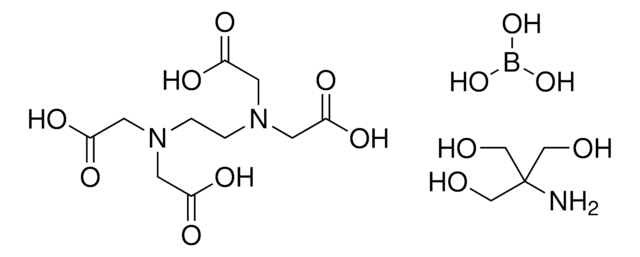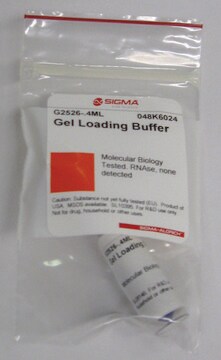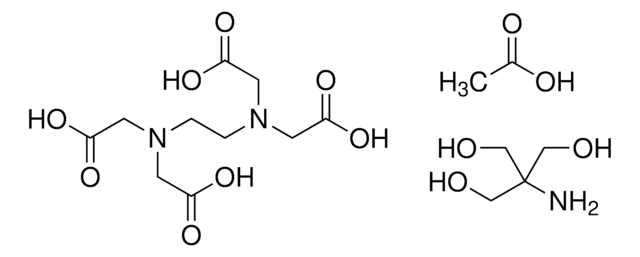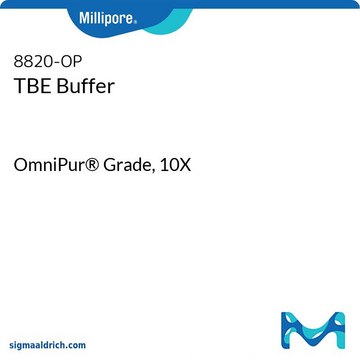T7527
Tris-Borate-EDTA buffer
BioReagent, for molecular biology, 5x concentrate, DNase and RNase, none detected, powder blend, suitable for electrophoresis
Sinónimos:
TBE buffer
About This Item
Productos recomendados
grade
for molecular biology
Quality Level
product line
BioReagent
form
powder blend
impurities
DNase and RNase, none detected
pH
8.1-8.5 (5 ×)
solubility
water: 85.1 g/L, clear, colorless
suitability
suitable for electrophoresis
application(s)
diagnostic assay manufacturing
SMILES string
OB(O)O.NC(CO)(CO)CO.OC(=O)CN(CCN(CC(O)=O)CC(O)=O)CC(O)=O
InChI
1S/C10H16N2O8.C4H11NO3.BH3O3/c13-7(14)3-11(4-8(15)16)1-2-12(5-9(17)18)6-10(19)20;5-4(1-6,2-7)3-8;2-1(3)4/h1-6H2,(H,13,14)(H,15,16)(H,17,18)(H,19,20);6-8H,1-3,5H2;2-4H
InChI key
OSBLTNPMIGYQGY-UHFFFAOYSA-N
¿Está buscando productos similares? Visita Guía de comparación de productos
Application
Dilution of the TBE stock concentrates to a 1× TBE running buffer results in a buffer containing 89 mM Tris-borate and 2 mM EDTA, pH 8.3. The 5× or 10× stocks may also be added to an acrylamide/bis-acrylamide stock solution for making the PAGE gel. Applied voltages of less than 5 V/cm (distance between the electrodes of the unit) are recommended for maximum resolution.
Packaging
4L poly bottle contains a powder blend that can be dissolved and reconstituted to prepare four liters of a 5× concentrate.
Preparation Note
Reconstitution
signalword
Danger
hcodes
Hazard Classifications
Repr. 1B
Storage Class
6.1C - Combustible acute toxic Cat.3 / toxic compounds or compounds which causing chronic effects
wgk_germany
WGK 1
flash_point_f
Not applicable
flash_point_c
Not applicable
ppe
Eyeshields, Gloves, type P2 (EN 143) respirator cartridges
Certificados de análisis (COA)
Busque Certificados de análisis (COA) introduciendo el número de lote del producto. Los números de lote se encuentran en la etiqueta del producto después de las palabras «Lot» o «Batch»
¿Ya tiene este producto?
Encuentre la documentación para los productos que ha comprado recientemente en la Biblioteca de documentos.
Los clientes también vieron
Contenido relacionado
Nancy-520 for DNA Detection and Quantitation
Nuestro equipo de científicos tiene experiencia en todas las áreas de investigación: Ciencias de la vida, Ciencia de los materiales, Síntesis química, Cromatografía, Analítica y muchas otras.
Póngase en contacto con el Servicio técnico






